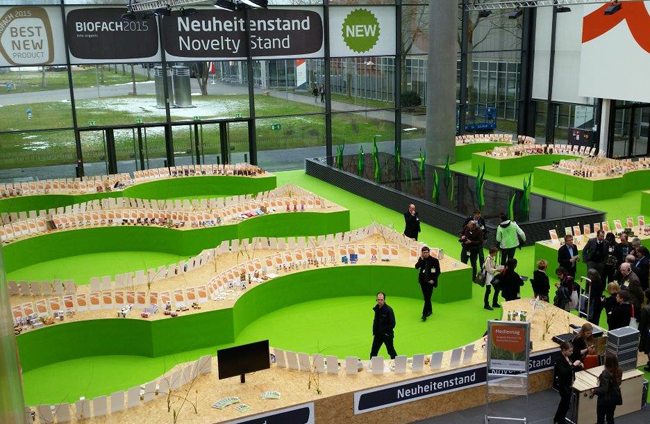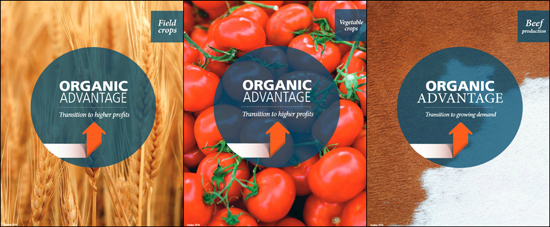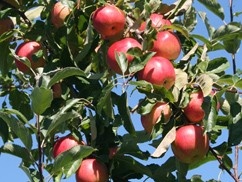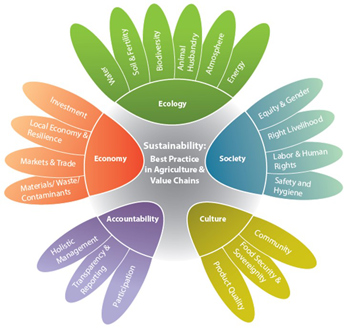Organic Friends' E‑zine: March 2015

Photo of the Month, by Andy Hammermeister
BioFach 2015, the world's leading trade fair for organic food, took place in Germany in February and was attended by over 44,000 visitors from 136 countries.
In this issue:
OACC Director's Message |
|---|
Organic 3.0 – Envisioning the Future of OrganicI recently had the privilege of attending BioFach, the world’s leading organic trade fair, held in Nuremburg, Germany. It is easy to see that organic has captured the imagination of the food industry, with over 2,200 exhibitors and over 40,000 trade visitors (i.e. not general public) attending. Products covered the full spectrum of the food industry and beyond, from baby food to bubble bath. |
- New Natural Weed Control Products for Organically Grown Products [PDF - 590 kB]
- Poster at Weed Science Society of America Conference. 2015
- Poster at Weed Science Society of America Conference. 2015
- Organic food processing survey
The Food Development Centre and MAFRD, in partnership with the Canada Organic Trade Association, with funding from Agriculture and Agri-Food Canada through the Organic Science Cluster II project, are conducting the first ever national survey of the specific challenges that organic food manufacturers face in bringing value-added organic food products to market. If your business manufactures organic processed food products to sell at Farmers' Markets, retail outlets or through any other sales channel, they would love to hear from you. Results of the survey will be used to help improve the business environment for organic food processing in Canada.
Horticulture
- Ecological Management of Key Arthropod Pests in Northeast Apple Orchards
- Sustainable Agriculture Research & Education. 2015
- Efficient Intercropping for Biological Control of Aphids in Transplanted Organic Lettuce
- USDA-ARS. 2014
Field Crops
Crop Rotation
- How to Choose Cover Crops [PDF – 191 kB]
- Midwest Organic & Sustainable Education Service. 2015
Pest Management
- Blasting the Competition Away: Air-propelled Abrasive Grits for Weed Management in Organic Grain and Vegetable Crops Recorded Webinar
- eOrganic. 2015
- Building Pest-Suppressive Organic Farms: Tools and Strategies Used by Five Long-Term Organic Farms Recorded Webinar
- eOrganic. 2015
- Managing Bad Stink Bugs Using Good Stink Bugs Recorded Webinar
- eOrganic. 2015
Livestock
- Mother-bonded and Fostered Calf Rearing in Dairy Farming [PDF – 1.3 MB]
- FiBL. 2015
Marketing and Economics
- The World of Organic Agriculture. Statistics and Emerging Trends 2015
- FiBL. 2015
- The European market for organic food
- Organic Eprints. 2015
Soils and Fertility
- A meta-analysis of soil organic matter response to soil management practices: An approach to evaluate conservation indicators
- Journal of Soil and Water Conservation (2014) 69: 422-430
- Tillage and rotational effects on exchangeable and enzyme-labile phosphorus forms in conventional and organic cropping systems
- Nutrient Cycling in Agroecosystems (2015) 101: 153-165
Horticulture
- Effects of Living Mulch and Fertilizer on the Performance of Broccoli in Plasticulture
- HortScience (2015) 50: 218-224
- Groundcover Management System and Nutrient Source Impacts on Soil Quality Indicators in an Organically Managed Apple (Malus ×domestica Borkh.) Orchard in the Ozark Highlands
- HortScience (2015) 50: 295-303
- Liquid Corn and Fish Fertilizers Are Good Options for Fertigation in Blackberry Cultivars Grown in an Organic Production System
- HortScience (2015) 50: 223-233
- Nematode community structures in different deciduous tree fruits and grape in Colorado, USA and impact of organic peach and apple production practices
- European Journal of Soil Biology (2015) 67: 59-68
- Orchard management influences both functional and taxonomic ground beetle (Coleoptera, Carabidae) diversity in South-East France
- Applied Soil Ecology (2015) 88: 26-31
- Strategies for Weed Management in Organic Hops, a Perennial Crop
- Agronomy Journal (2015) 107: 634-640
- Trailing Blackberry Genotypes Differ in Yield and Postharvest Fruit Quality during Establishment in an Organic Production System
- HortScience (2015) 50: 240-246
- Using ground beetles (Coleoptera: Carabidae) to control slugs (Gastropoda: Pulmonata) in salad greens in the laboratory and greenhouse
- The Canadian Entomologist (2014) 146: 567-578
Crop Rotation
- Cover-Crop Species as Distinct Biotic Filters in Weed Community Assembly
- Weed Science (2015) 61: 282-295
Pest Management
- A meta-analysis of physiological and behavioral responses of parasitoid wasps to flowers of individual plant species
- Biological Control (2015) 82: 96-103
- Which conditions determine the presence of rare weeds in arable fields?
- Agriculture, Ecosystems & Environment (2015) 203: 55-61
Livestock
- A deductive approach to animal health planning in organic dairy farming: Method description
- Organic Eprints. 2015
- Different perspectives on animal health and implications for communication between stakeholders
- Organic Eprints. 2015
- Organic Eprints. 2015
- Effect of Melissa officinalis supplementation on growth performance and meat quality characteristics in organically produced broilers
- British Poultry Science (2014) 55: 774-784
- Growth performance of fast-growing broilers reared under different types of production systems with outdoor access: Implications for organic and alternative production systems
- The Journal of Applied Poultry Research (2014) 23: 212-220
- The risk factors affecting the development of vent pecking and cannibalism in free-range and organic laying hens
- Animal Welfare (2015) 24: 101-111
Ecology and Environment
- Do farming practices affect natural enemies at the landscape scale?
- Landscape Ecology (2015) 30: 125-140
- Quantifying the impacts of ecological restoration on biodiversity and ecosystem services in agroecosystems: A global meta-analysis
- Agriculture, Ecosystems & Environment (2015) 202: 223-231
Nutrition, Safety and Health of Organic Foods
- Estimating Pesticide Exposure from Dietary Intake and Organic Food Choices: The Multi-Ethnic Study of Atherosclerosis (MESA)
- Environmental Health Perspectives (2015)
- Fatty acid profile differs between organic and conventionally produced cow milk independent of season or milking time
- Journal of Dairy Science (2015) 98: 1411-1425
Post-harvest Handling, Storage and Processing
- Quality assessment of baby food made of different pre-processed organic raw materials under industrial processing conditions
- Journal of Food Science and Technology (2015) 52: 803-812
Social Science
- Leveraging the Local: Cooperative Food Systems and the Local Organic Food Co-ops Network in Ontario, Canada
- Journal of Agriculture, Food Systems and Community Development (2014) 4: 47-60
- Organic Farming in West Virginia: A Behavioral Approach
- Journal of Agriculture, Food Systems and Community Development (2014) 4: 155-171
Marketing and Economics
- Tradeoffs between sensory attributes and organic labels: the case of orange juice
- International Journal of Consumer Studies (2015) 39: 162-171
- Drafts of the revised Canadian Organic Standards documents that will be balloted by the Technical Committee on Organic Agriculture
All proposed modifications to the Canadian Organic Standards have been inserted, editorial reviews have been done, and the voting members of the Technical Committee on Organic Agriculture will now cast their votes: the first 30-day ballot was launched on February 24, 2015. Please note that this is not a public review.
- Latest proposed answers to questions regarding the National Standards for Organic Agriculture [PDF - 370 kB]. Comment period open to April 13, 2015
- Standards Interpretation Committee. 2015
- Standards Interpretation Committee. 2015
- Organic Value Chain Roundtable's Organic Advantage Documents
- Organic Advantage: Beef Production [PDF - 5.0 MB]
- Organic Advantage. Field Crops [PDF - 4.7 MB]
- Organic Advantage. Vegetable Crops [PDF - 5.3 MB]
- Organic Advantage: Beef Production [PDF - 5.0 MB]

- Ph.D. Graduate Research Assistantship: Interseeding cover crops in grain corn for improving soil health - Trent University [PDF - 135 kB]
- Job opportunities with TapRoot Farms:
- Production Team Member
- Gardener and Herb Grower
- CSA Office Administrator and Bookkeeper
- Livestock Farm Worker
- Production Team Member
| Event | Location | Date |
|---|---|---|
| Manitoba Organic Farm Production Club Meetings |
Various locations in Manitoba | March 7, 14, 21 and 24, 2015 |
| Organic Farming and Soil Management at the European Geosciences Union General Assembly 2015 |
Vienna, Austria | April 12-17, 2015 |
| 5th International Conference on Organic Agriculture Sciences |
Bratislava, Slovakia | October 14-17, 2014 |
Organic Friends' E-Zine March 2015, Volume 11, Issue 5
|



